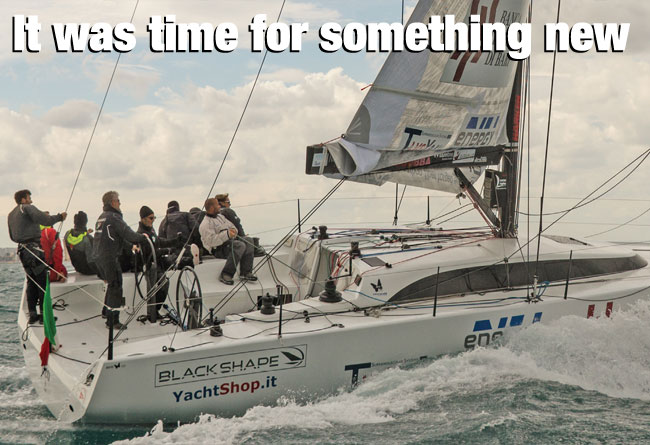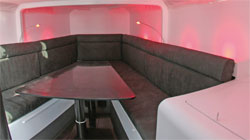

Paolo Semeraro, former Olympic and America’s Cup sailor and the owner of Banks Sails Italy, is the project manager of the NEO 400 project. America’s Cup designer, and the man behind the Costa Concordia salvage, Giovanni Ceccarelli provided the design flair…
I have been working closely for many years now with the main production boatyards in Italy, designing sails as well as optimising and then racing their boats. I have also managed a number of custom projects including a pair of GP42s and the racing maxi Roma. When an old customer came to me last year and asked ‘What kind of boat should I buy?’ my immediate response was to enquire, ‘What kind of use do you imagine for your boat?’
‘Well,’ he answered, ‘three weeks of summer cruising in Greece or Croatia or Sardinia, plus lots of day-sailing, in all weather conditions, plus local ORCi and IRC regattas, a couple of classic distance races like the Giraglia and Middle Sea Race and finally a couple of major ORCi events like the worlds…’ Adding finally that ‘I would also like a modern-looking, easy-to-maintain yacht.’ My response: ‘Wow! A boat like that I would like to own myself.’
We duly trawled the marketplace but nothing came close to meeting such a diverse brief. Most production yachts were too heavy and also they all looked the same! An alternative approach could be to buy a used race boat like an old Farr 40 or TP52, but no way would you cruise these boats. Nor are they ideal for longdistance races. And how much time and money would you then need to ‘invest’ to optimise for ORCi or IRC? There are of course also some fast new HPR-specific designs, but they are for sure not adapted for European needs and would be hopeless for cruising.
So, in partnership with our client, we decided to create our own new concept… Neo Yachts.
Neo Yachts and Composites was created in Bari at the heel of Italy where many of the country’s best composite workers are located. From the outset we also specified the very best technical partners including Gurit for composites, Future Fibres for rigging, Harken for hardware and so on.
Giovanni Ceccarelli was chosen from a talented line-up of Italian design talent, with work starting in the second part of 2012, beginning with a detailed analysis of the best – and the not so good – IRC and ORCi projects of recent years.
The first decision was the choice of ORCi GPH range, fast but not too fast, to rate well under a TP52 but sail well clear of the bulk of the existing cruiser-racer fleet. A GPH (2012) number around 530 was decided on, along with a length of 40ft, meaning a powerful boat but with reasonable running costs. In fact we have ended up with a 2014 ORCi GPH of 526.7 and IRC TCC of 1.195.
Meanwhile, we used our Banks Sails AeroAnalysis sail design software to create a sailplan that would deliver high average speeds in all conditions, while being easy to use, well balanced and modern. We eliminated all extremes of over-long bowsprits or over-sized mainsails. We set the mast quite far aft to permit generous but non-overlapping jibs, with upwind sail area nicely balanced between mainsail and jib (this means easy driving and no need to have an America’s Cup sailor as a mainsail trimmer…).
We went for a light but not too light displacement, for a wide yacht above the water but with modest wetted surface. A yacht with a comfortable interior that would also perform well in typical Mediterranean light airs. This combination of interior volume and moderate displacement meant that high-tech construction was a must, and we turned to Gurit to advise on a suitable specification.

The interior details were finalised during the 2012 Middle Sea Race, which I sailed on an XP-44 (we won our class) that featured one of the most modern interiors at that time. We decided to make an interior that could be used for racing in all weather conditions but that with some simple rearrangement could seat 10 around a table for dinner! We called this ‘convertible’ solution (above-right) the Loft Version.
There are three gimballed beds down below, plus plenty of hand holds for heavy weather. There are no sharp edges, but there is a spacious bathroom (with electric carbon toilet as standard!), a 170-litre fridge and a modern galley arrangement.
On deck there is a huge cockpit, nice for racing but also with lots of space behind the twin wheels for tanning and generally relaxing. A substantial aft locker keeps all the deck clutter well away from the interior, separated from the cabin by a waterproof bulkhead and with its own automatic bilge pump. In the bow another waterproof bulkhead separates the cabin from a large sail locker with plenty of room to stow a Code 0 and a gennaker when cruising.
We have now sailed the first Neo 400 for more than 20 days and she is already exceeding expectations, winning local ORCi events and offering a thoroughly modern sailing experience.
Paolo Semeraro – Neo Yachts & Composites
Click here for more information on Neo Yachts & Composites »
We invite you to read on and find out for yourself why Seahorse is the most highly-rated source in the world for anyone who is serious about their racing.
To read on simply SIGN up NOW
Take advantage of our very best subscription offer or order a single copy of this issue of Seahorse.
Online at:
www.seahorse.co.uk/shop and use the code TECH20
Or for iPad simply download the Seahorse App at the iTunes store


